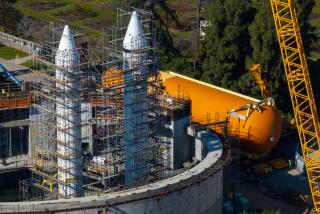Tankers at 25,000 Feet Fuel the War Effort
- Share via
ABOARD A U.S. REFUELING PLANE OVER IRAQ — On the ground 25,000 feet below, American troops were in trouble. A firefight was underway and a U.S. soldier had been shot and killed.
U.S. Air Force F-16s, picking up the action on their radios, swooped over Iraq’s western Al Anbar province, searching for the insurgents’ position. After an hour of buzzing the ground -- and dropping no bombs -- the jets needed gas.
Overhead, flying in a lazy oval, was Spark-02, a KC-135 air refueling tanker filled with 33,000 gallons of high-grade jet fuel, waiting to give some away.
In what has become a routine operation, a ground controller directed the empty F-16s toward the tanker, which looks like a giant gray wasp with a 30-foot-long refueling boom dangling from its tail. The boom operator, Airman 1st Class Phil Inmon, coached the fighter pilots closer and closer until an F-16 had attached itself to the boom. After guzzling fuel like a hummingbird sipping nectar, it let the second F-16 have a turn.
“We’re a gas station in the sky for these guys,” said Inmon, 22, of Kingston Springs, Tenn.
Air-to-air refueling, like this Aug. 31 operation, is one of the biggest and most intricate logistical enterprises in the wars in Iraq and Afghanistan, and one of its untold tales. Identical aerial ballets take place dozens of times a day, every day, over the two countries.
“We don’t drop bombs or shoot bullets, but we’re a critical part of the mission,” said Lt. Col. Tim Sipes, 43, of the Air Force’s 908th Expeditionary Air Refueling Squadron.
This year alone, the Air Force has offloaded more than 77 million gallons of jet fuel in the air. That’s almost $135 million in gas at the Pentagon’s discounted price of $1.74 per gallon, said Capt. David Small, spokesman for U.S. Central Command Air Forces in Qatar.
Every day, 35 of the lumbering tankers dispense fuel over Iraq and Afghanistan, and have been doing so for years.
Aerial refueling over Iraq has been going nonstop since America and Britain began enforcing “no-fly” zones in 1992, and started over Afghanistan with the U.S.-led bombing in late 2001, said Master Sgt. Devan DeBarr, 41, who schedules tanker flights for the air command cell at Al Udeid Air Base in Qatar.
At any given hour over Iraq, well beyond the reach of insurgents’ missiles, six or more tankers are circling in blocks of Rhode Island-size airspace set aside for refueling. Customers include fighter jets, Special Forces AC-130 gunships and even giant B-52 bombers.
The boom operator lies on his belly and jiggles a pair of joysticks that adjust small wings on the boom, allowing him to guide the pipe until it locks onto the gas tank of the plane below. Once the gas is flowing, the F-16’s tank fills in a minute or two.
Air refueling, a 10-minute diversion for a fighter jet, allows the Air Force to maintain continuous air cover for ground troops. Without it, fighters and bombers would have to leave the battle and fly back to a ground base for more gas. That would take at least an hour.
“You’ve got to think how much slower this war would be without us,” said Inmon, his close-cropped reddish hair matching his flight suit.
Spark-02, a modified Boeing 707, is among a fleet of the Air Force’s oldest jets, some 50 years old. The planes are not without problems. Spark-02’s air conditioning was broken, leaving the plane’s crew sweltering on the runway. The heat tripped breakers controlling its onboard computer, and a sensor in the refueling boom also had to be fixed before takeoff.
The pilot, 29-year-old Capt. Scott Meyer of Yorktown, Va., said he lost control of the plane’s flaps a month ago on his 100th refueling sortie over Iraq and had to circle for eight hours to burn off enough fuel to land.
Accidents happen too. Once, Meyer said, a pair of F-18s collided after refueling and crashed. Another time, his own KC-135 almost slammed head-on into a pair of Navy F-14s.
“The computer told us to climb and we climbed right over them,” Meyer said.
The daily refueling ballet is choreographed by a “tanker cell” at the Air Force’s Combined Air Operations Center at Al Udeid.
Former pilots like DeBarr coordinate the fuelers, telling them which “tracks” to circle in. Over Iraq, about 10 quiet eddies of airspace have been set aside as tracks, or midair gas stations.
Each track is marked on air charts as a red box, 60 miles by 30 miles, and is given a woman’s name, such as Maude. The trip to the war from bases outside Iraq and Afghanistan can take hours.
Tanker pilots like Meyer say their jobs are among the best in the war zone, even if they’re unsung. The job of boom operator, Meyer said, is considered one of the finest enlisted careers in the U.S. military. “You can have a 19-year-old kid handling the refueling of a B-2,” Meyer said. “That’s a billion-dollar asset.”
More to Read
Sign up for Essential California
The most important California stories and recommendations in your inbox every morning.
You may occasionally receive promotional content from the Los Angeles Times.













